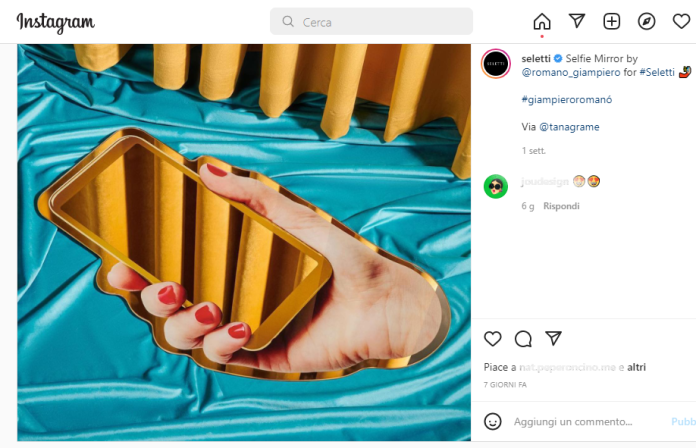It was not love at first sight, but something has changed. Or is changing. The world of design and social networks might seem like a natural fit, given the intrinsic passion for images, sharing and creativity. But instead, “especially at first, there were misunderstandings and distrust; today, however, there are many virtuous examples with a contemporary approach,” says Riccardo Crenna, co-founder and creative director of Simple Flair, a digital consulting firm aimed precisely at design companies.

The lag time can be explained as follows: “The sector was once managed mostly by creatives, with a more experimental spirit; today design companies are often run by people with a background in economics and business, and while it is true that companies are boosting revenues tenfold, it is also true that they become more conservative, unlike those in the fields of fashion and food.”
In spite of delays, the situation seems to have been definitively unblocked, as could be seen when important Italian brands recently began using even TikTok, the youngest social network at the moment (‘young’ in all senses of the term). “On TikTok our goal is not just to show products, but also to tell the story of the brand,” says Alessandro Davolio, Digital Marketing Manager of Seletti, a company that for its launch on this network has collaborated with Defhouse, a true creative tiktokers company.
In effect, using the social networks should mean just this, Crenna observes. “Not to demonstrate size, numbers, products, but to share values and establish a relationship with your own community, or – to be more pragmatic – with your own ‘clients.’” The example is clear: “A company that produces Land Rovers does not sell only a car with amazing wheels and parts; it also sells the dream of exploring the world, a dream of adventure. To truly stand out, every company has to learn to illustrate its system of values and to share it, creating empathy with products.”
“The social networks should not be used to demonstrate size, numbers, products, but to share values and relationships with your community”
But by now there are many social networks, so it has become necessary to differentiate the approach, now more than ever before. “Each one has its own particularities, its own aims,” says Simone Goffo, Marketing Coordinator of LAGO Spa, one of the first Italian design companies to make its debut on web 2.0. “The Meta galaxy is our solid ground – over the years we have built a community of over one million fans and followers. Nevertheless, TikTok is the new channel that addresses a completely different generation. LinkedIn helps us for more institutional communications, and to find human resources. We interact on Pinterest with niches that pay attention to and are interested in design.”

To be effective on all fronts, companies need to have a prior strategy, and they cannot afford to improvise. Crenna is convinced: “Already tomorrow a new social network could appear, and we need to be ready, already structured. The social networks should be seen only as the last mile, the one that enables you to establish dialogue with the community.”
At Lago they are aware of all this. Goffo says, “each network can be considered an ecosystem that uses its own rules and languages,” but in general “listening is what really counts.” The objective is to “attract people who share our same values and can identify with our products.”
According to Crenna, behind every object – a table, a lamp, a chair – there has to be a story, a narrative, starting with the creative process. This also produces pragmatic interactions: “To tell the story of a product enables people to understand why that item costs so much, what is behind it. And it can trigger the motivation to buy one car instead of another, to stay in one hotel instead of another.”
Facebook, Instagram and TikTok are the most important social networks at the moment, but they address three different demographic targets, with different levels of buying power. A selection has to be made a priori, Crenna suggests, but if you want to also have impact with Generation Z, you have to be ready to “get bare” and, above all, “to not take yourself too seriously.”
Though videos on scientific topics can be seen on TikTok, the common denominator is fun, and no one is exempt from this aspect. “Especially for big name brands, managing not to take yourself too seriously is very helpful, it’s a humanizing factor. If even an institution like the Uffizi Gallery has made compromises, it means this is truly a winning path: no one thinks the Uffizi have less value today, just because they have posted memes on TikTok.”

Another strategic factor in social communication is the “simultaneity of online and offline,” Crenna says. “By now there is no longer a boundary: every space has to work both in its social network activities and in its live events.”
In this regard, Davolio from Seletti remarks that at Christmas 2021 the company involved young, popular tiktokers in an event inside the Milan showroom on Corso Garibaldi. “We know that to achieve engagement with Generation Z we need increasingly ironic, dynamic storytelling for our products, but it is also important to have physical contact with this target.”
Both Lago and Seletti have an in-house division for digital communication. “The reason is simple,” they say at Lago. “No agency could get 100% inside the heart of the company.”
“This is true,” Riccardo Crenna agrees. “In fact, as a consulting company we work alongside the company, not taking the place of the in-house team. Outsourcing everything makes no sense, the social networks have to narrate the DNA of the company, and only those who work inside the firm can to that. Our method calls for training and location of resources. It is a ‘two-handed’ operation, creative from the outside, operative from the inside.”
The most common mistake, in any case, is to turn to an advertising agency that also works on other sectors. An architect, like the other founder of Simple Flair, Simona Facco, Crenna believes that “the world of design is particular, and someone who knows about motors cannot just start working in this context. More and more, on the social networks we are expected to talk about things we have to know. This already makes the difference, and it will be even more important in the future. With respect to the beginnings, today it is truly the quality that counts.”







